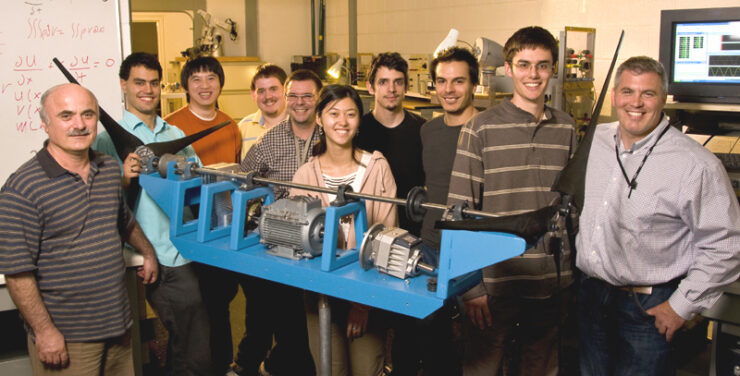
Green Engineers develop new design for wind turbines
GREEN ENGINEERS, A club for professors and students, has been developing an innovative wind turbine over the past three years. The invention, already published in academic journals, features two sets of blades to increase efficiency and decrease noise—problems associated with current versions of wind turbines.
“We are building a source of energy,” said Riadh Habash, professor in the Faculty of Engineering at the U of O and member of Green Engineers. “Anyone can build a wind turbine, but this is a scientific process. We first looked for a new idea [of how] to enhance the efficiency of the wind turbine. What we thought of was the contra-rotating process: Two sets of blades. This is a proven technology in water pumps so we wanted to implement it in wind turbines.”
Habash explained the prototypes of the contra-rotating turbines are less noisy and 40 per cent more efficient than regular wind turbines.
“The noise is [caused] because of vibrations [running] through the tower into the ground,” said Habash. “We realized when you have two systems operating in opposite directions that helps reduce the noise.
“There is always a problem with poor quality,” he added. “Many wind turbine projects built on farms are not permitted to be connected to the grid, because [wind turbines] have a lot of distortion—it is dirty energy. Our group, along with an industrial partner, have built a generator that gives clean energy.”
Habash also explained this is a valuable and unique learning experience for the students involved.
“Students are not only learning technology,” said Habash. “This is hands-on experience, research experience, and project management experience. They learn how to develop technologies for the community. We see that in the near future, there will be multiple projects within our communities, so we are working to build technologies for these projects.”
George El-Hage, a first-year master’s student in mechanical engineering and member of the Green Engineers, said working on the new turbines gave him an advantage in the professional world.
“This is going to be on my resumé afterward,” said El-Hage. “I was happy when I learned about Green Engineers. I got to learn how to deal with a company I can’t go see and deal with a company I see all the time—deal with finances—things I don’t see in class. In a job interview, I will get the leg up on someone who didn’t have this kind of experience.
“I think this was definitely one of the defining moments of my undergrad, working with the Green Engineers group,” he added. “The first thing we’re told when we get into university is, ‘Get involved.’ Only after you get involved do you understand why [you’re told that].”
The team has been recognized with a number of awards for their work on the wind turbine. In 2010, they were awarded the Ontario Power Authority’s award for Best Power Conservation Project. The team’s prototypes will also be on display at the National Science and Technology Museum for the next six years.
“We have more than 15 industrial, community, and innovation partners,” said Habash. “It is not only [about] teachers and students but industry, community, and government as well. I have been a teacher for more than 30 years and taught in many different ways, but this is an amazing experience for me and I learn more than I teach. It is [not] an exercise that ends, [but] is an exercise that is continuous. It is innovation.”
—Written by Christopher Radojewski, with files from Jane Lytvynenko



